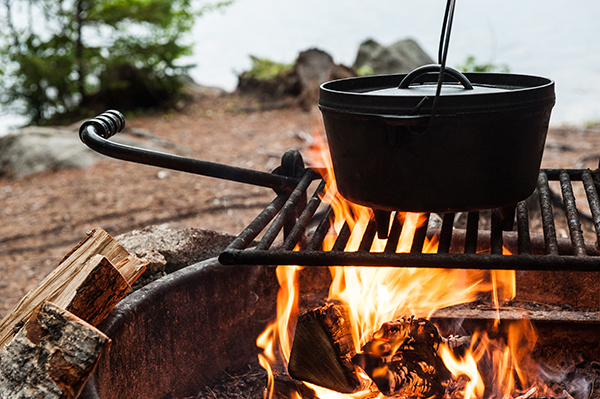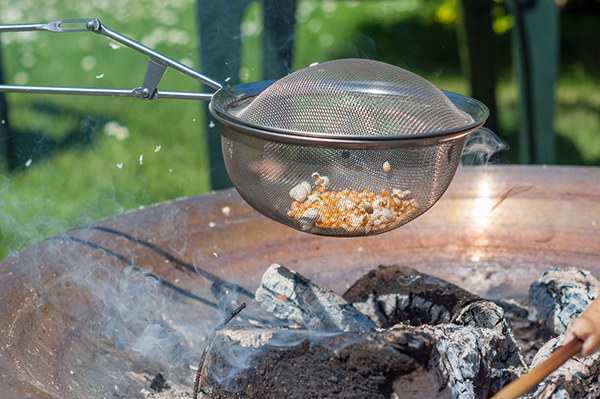by Andy Gricevich, Newsletter Writer
 It’s prime camping season! Maybe you’re going on a solo backpacking excursion deep in the woods, or maybe it’s a car camping trip to a state park with family or friends. Whatever approach you’re taking, it’s easy to get overwhelmed by preparations like what gear to bring and what to eat. Once you’ve got it all together, it’s time to head for the outdoors, and to put your perfectly organized plans to the test.
It’s prime camping season! Maybe you’re going on a solo backpacking excursion deep in the woods, or maybe it’s a car camping trip to a state park with family or friends. Whatever approach you’re taking, it’s easy to get overwhelmed by preparations like what gear to bring and what to eat. Once you’ve got it all together, it’s time to head for the outdoors, and to put your perfectly organized plans to the test.
Keeping everybody fed and cleaning up after meals can add unnecessary stress to an activity that’s supposed to be relaxing. There are definitely some folks who enjoy the challenge of producing a gourmet meal while camping. For them, there are plenty of fancy ideas online, from elaborately marinated grilled brie to stuffed French toast to 25-ingredient curries. For those who won’t find it worth all the work it’s best to pack the easiest, least perishable, most nourishing food available. Remember—even the simplest things taste better around the campfire!
The most important part of your camp meal plan is the macronutrients: fats, protein, and carbohydrates. The right balance of nutrient-dense foods gives you the energy you need to hike, swim, fish, or whatever activities are part of your camping trip. Unless you’re going to be in the wild for a long time, there’s little need to worry too much about maximizing vitamins and minerals, or avoiding salt. It’s about full bellies and enjoyment.
If you’re trying to go minimal, you’ll also want to include a lot of food that requires little to no preparation, and to keep it simple when it comes to the gear required for whatever you are going to cook. If you’re car camping, it’s hard to beat a cast-iron Dutch oven—especially one whose lid doubles as a skillet–for versatility and the ability to cook with a variety of heat sources.
Another popular, and extremely useful, camp cooking tool is the pie iron. It’s basically two cast-iron skillets that lock together on a long handle. Pie irons allow for controlled cooking over coals or a fire, and you can make a range of delicious hot dishes in them. A small, portable propane camp stove can be helpful–as can a simple campfire cook stove—but it can save a good deal of packing and hauling to focus on what can be cooked on a bed of coals or over an open flame. Cooking with fire also connects us with something elemental and ancient, and can deepen our experience during our time outdoors. Beyond that, a cooler with an ice pack and a few essential dishes and utensils can pretty much take care of things–or just carry sturdy or non-perishable foods in a backpack.
DINNER
The tried-and-true camp foods are classics for a reason. It doesn’t take much more than a bag of chips to accompany hot dogs for dinner, cooked perfectly over a fire—and hot dogs keep well in the cooler. If that’s not fancy enough, and you must boil water, boxed macaroni and cheese with sliced dogs thrown in adds delicious fats and filling carbs. Given sufficient skill at the fine art of stick-carving (or maybe you just brought skewers), veggie and/or meat kebabs are another good right-over-the-coals option. You’ll want to cook any meat on its own skewer in order to make sure things aren’t over— or underdone—and, with any camping food, chopping everything at home before your trip will save you time preparing meals and cleaning up afterwards. Also, of course, many kiddos—and many adults—are likely to demand s’mores to finish off their fire-cooked meals.
It’s so easy to bake potatoes, carrots, onions, or corn on the cob wrapped in foil at the edge of a bed of coals. Don’t forget to bring salt on your trip! If you’ve diced some of these vegetables in advance, a foil-wrapped hash can be a nice way to have something hot for breakfast without much work. Apples baked in foil are a delicious dessert in themselves; coring them beforehand with a knife (because you brought a knife—preferably one all-purpose knife—right?), then filling them with brown sugar and cinnamon, takes it up a notch, and is a perfectly acceptable bit of added labor. All these fruits and veggies hold up well in a bag or cooler.
When it comes to cooking food in pots and pans (remember, you’ll have to wash them), ready-to-eat soups and stews, whether made at home and canned or store-bought, are easy to heat in a Dutch oven, and can make for a filling dinner that provides plenty of depth of flavor. Chili or sloppy Joe filling, made ahead (or from a can) heat up well in a pot set on a bed of hot coals. Your Co-op grocery department also offers a variety of delicious, ready-to-eat, shelf stable Indian and Thai curries in foil packets, and bringing some of those along on a camping trip may offer the only justification for the existence of pre-cooked rice—though you could also buy some naan or other flatbread with which to scoop up the sauce.
If you can’t resist making a more elaborate dinner but still only want to use one pot, there are some good ideas out there. Dutch oven nachos are easy and, unsurprisingly, delicious. Put some aluminum foil in the bottom of the pot (this will save you some cleaning time later), then repeat layers of corn chips, cheese, and whatever other toppings you decided to bring—including anything, like ground meat, that you’ve pre-cooked at home.
Popcorn in a Dutch oven makes for an easy evening snack; as with any cast-iron camp cooking, you’ll need hot pads or heat-resistant gloves. In the frying pan, quesadillas are a great minimalist option. All you need are your favorite tortillas, a pre-shredded cheese blend, and a jar of salsa, and you’re good to go. Given a grill, steaks, burgers or a vegetarian alternative, or any other cookout classics will surely satisfy, if prepared for cooking in advance. It’s best to use up any such perishable foods on the first night.
There are plenty of good pie iron recipes online. Most involve putting a slice of bread into each half of the oiled pie iron, adding additional ingredients, and winding up with a delicious hot sandwich. You can also use tortillas, other wraps, biscuits or hamburger buns to make quesadillas, pizza pockets or pudgy pies. This tool really expands the possibilities for one-dish camp cooking.
 WHAT’S FOR BREAKFAST?
WHAT’S FOR BREAKFAST?
It can be easy to relax into cooking dinner at the end of a day in the woods. In the morning, though, most of us want to get going, rather than take up too much daylight time with getting food in our bellies. For a hot breakfast, one solution is to have someone along on the trip who enjoys getting up before everyone else, getting a fire started, and preparing a bed of coals to cook something simple. The propane stove is another, since it can be turned on and off instantly. Again, nobody wants to wash a pile of breakfast dishes, so we’re mostly looking for simple classics that require minimal equipment.
Eggs are a more or less perfect food, especially from pasture-raised hens. In addition to protein and essential omega-3 fats, they provide many important nutrients and give us plenty of good fuel for the day. Hard-boiled in advance for no-cook breakfasts (they make a nice enough morning sandwich) or hiking snacks, they’ll keep well for at least a few days in a cooler. A favored method for perfect hard-boiled eggs is to put them in a pot with cold water, bring it to a boil, shut off the heat and set a timer for seven minutes before removing the eggs and cooling them in cold water. By all means, though, make simple fried eggs in your skillet for a good camp breakfast. If you’ve brought plenty of butter, make pan toast as well—it’s hard to beat.
Tubes of biscuits or cinnamon rolls cook easily in a Dutch oven on the coals. If you want to prepare food in advance of your trip, you can make breakfast burritos, wrap them in foil, and heat them on the coals. If you’re okay with heating plastic for a few minutes, fill ziplock bags with egg, cheese, veggies, and whatever else you’d like. Get water boiling in your pot, drop the bags in, and you end up with sous vide omelets! The pie iron is also great for omelets, eggs in a nest (put in a bunch of frozen hash browns and crack an egg into the middle), breakfast sandwiches, French toast, and more.
Avoiding cooking in the morning is easy, though. Granola and yogurt, with some fruit added, make for a fine breakfast parfait. Keep in mind that berries don’t hold up for too long, so you’ll want to eat those toward the beginning of your trip. You can also make overnight, no-cook oatmeal: for each half-cup of dry quick oats, add one cup of water and a pinch of salt in a sealable container, shake it up before climbing into your sleeping bag, and let it sit in the cooler overnight. Some dried fruit (raisins, cranberries) and seeds (hemp, chia, ground flax) will make it more nourishing and delicious. You can add nut butter and/or sweeteners in the morning for a sustaining start.
SNACKS AND LUNCHES
Here’s where you really want to go simple. Nobody wants to haul a large amount of food around on a hike, or spend the rest of the morning packing lunches after breakfast. For snacking and lunching, you’re pretty much going for satisfying calories.
Nuts are generally superfoods, and a bag of them goes a long way on its own. Trail mixes, whether homemade or bagged up in the bulk aisle, come in countless varieties. It doesn’t get much easier than granola and protein bars. Cheese sticks hold up well in your backpack, and obviously pair well with crackers. Throw in a carrot, a just-ripe avocado, an apple or orange, or any other fruit or vegetable that can take a bit of a beating or heating, and your snack package is complete.
A simple lunchmeat and cheese sandwich or PB&J (or nut butter on crackers, or fruits and vegetables) never fails to taste amazing to hungry hikers in the middle of the day. Wraps with hummus and veggies are a good bet as well, and many have been sustained in the woods by a can of sardines or tuna. For lunch at the campsite you might get a little more elaborate with some tried-and-true picnic foods, made ahead: pasta salad, bean salad, melon or other satisfying fare. In any case, lunch while camping is the time to take a break and relax, and it’s easy to keep it that way.
EATING WILD
Your trip can be made even more fun, and deepen the nature connection aspect of the experience, by eating at least something from the woods, prairies, or waterways around you. If you or anyone you’re with fishes, it’s hard to have a better dinner than grilled or pan-fried trout or bluegill, or a good catfish baked in foil by the fire. Try learning a few easily identifiable edible plants; depending on the rules of the place you’re camping, you may be allowed to harvest some greens, herbs, or mushrooms. A little watercress is great on a ham and cheese sandwich, and some wild garlic or onion tops can take that fish to the next level. Almost any place you’re visiting will allow you to pick summer berries, or apples from a long-abandoned orchard. Who doesn’t like to do that?
Whether you’re into “primitive” cooking on hot stones, grilling, or the convenience of packages—or making five-course camp banquets and bringing an extra bus tub for the dishes—eating in the outdoors brings a particular satisfaction with it. Hungry, tired, and (hopefully) relaxed, surrounded by the songs of crickets and toads and the flashing of fireflies, we feel grateful for every bite. Kids remember camp meals for their whole lives. Rather than a daily necessity we need to plan for and, most of the time, simply get out of the way, eating becomes part of a whole experience of living on the planet. It’s a beautiful thing. And we get s’mores.










